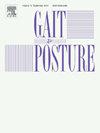老年人爬楼梯时姿势控制对脚趾间隙的影响
IF 2.4
3区 医学
Q3 NEUROSCIENCES
引用次数: 0
摘要
背景衰老会干扰老年人的姿势控制,影响他们进行日常活动的功能能力,如走路和爬楼梯。因此,老年人在爬楼梯时,脚趾与台阶的间隙往往更小,这反映在摔倒的风险更大。然而,没有证据表明姿势控制对老年人爬楼梯时脚趾间隙的影响。研究问题:在老年人爬楼梯时,姿势控制的表现是否影响脚趾清除行为?方法对16名健康老年人进行研究。参与者被要求上下一个四级台阶,距离一米远。为了评估姿势控制,参与者被指示站在力台上,并执行以下姿势:1)半串联基座和2)单腿基座。计算两肢着地和过渡时刻的脚趾间隙;考虑了时间变量平均摇摆振幅和总平均速度。结果空间控制时间变量可以部分解释楼梯协商过程中脚趾间隙行为。在上下楼梯时,平均摇摆振幅对半串联基座的影响更大。这些结果允许识别与绊倒和在楼梯上跌倒相关的风险,以及训练老年人在楼梯上行走时更好的姿势控制和运动表现。本文章由计算机程序翻译,如有差异,请以英文原文为准。
The influence of postural control on toe clearance during stair negotiation in older adults
Background
Aging interferes with postural control in older adults and affects their functional ability to perform daily activities, like walking and stair negotiation. As a result, older adults tend to have less toe clearance in relation to the step during stair negotiation, which is reflected in a greater risk of falling. However, there is no evidence of influence of postural control on toe clearance performance during stair negotiation in older adults.
Research question
Does the performance of postural control influence toe clearance behavior during stair negotiation in older adults?
Methods
This study was conducted on 16 healthy older adults. Participants were asked to go up and down a stair with four steps that was one meter away. To assess postural control, participants were instructed to stand on the force platform and perform the following postures: 1) Semi tandem base and 2) single leg base. The toe clearance was calculated for landing and transition moments for both limbs; the temporal variables mean sway amplitude and total mean velocity were considered.
Results
Postural control temporal variables can partly explain toe clearance behavior during stair negotiation. A greater influence of mean sway amplitude was found in the semi tandem base during stair ascent and descent.
Significance
These results allow the identification of the risk related to tripping and falling on the stairs, as well as training for better postural control and locomotor performance in older adults during stair negotiation.
求助全文
通过发布文献求助,成功后即可免费获取论文全文。
去求助
来源期刊

Gait & posture
医学-神经科学
CiteScore
4.70
自引率
12.50%
发文量
616
审稿时长
6 months
期刊介绍:
Gait & Posture is a vehicle for the publication of up-to-date basic and clinical research on all aspects of locomotion and balance.
The topics covered include: Techniques for the measurement of gait and posture, and the standardization of results presentation; Studies of normal and pathological gait; Treatment of gait and postural abnormalities; Biomechanical and theoretical approaches to gait and posture; Mathematical models of joint and muscle mechanics; Neurological and musculoskeletal function in gait and posture; The evolution of upright posture and bipedal locomotion; Adaptations of carrying loads, walking on uneven surfaces, climbing stairs etc; spinal biomechanics only if they are directly related to gait and/or posture and are of general interest to our readers; The effect of aging and development on gait and posture; Psychological and cultural aspects of gait; Patient education.
 求助内容:
求助内容: 应助结果提醒方式:
应助结果提醒方式:


